A week ago today Black-billed Magpies were diligent about their nest-building.
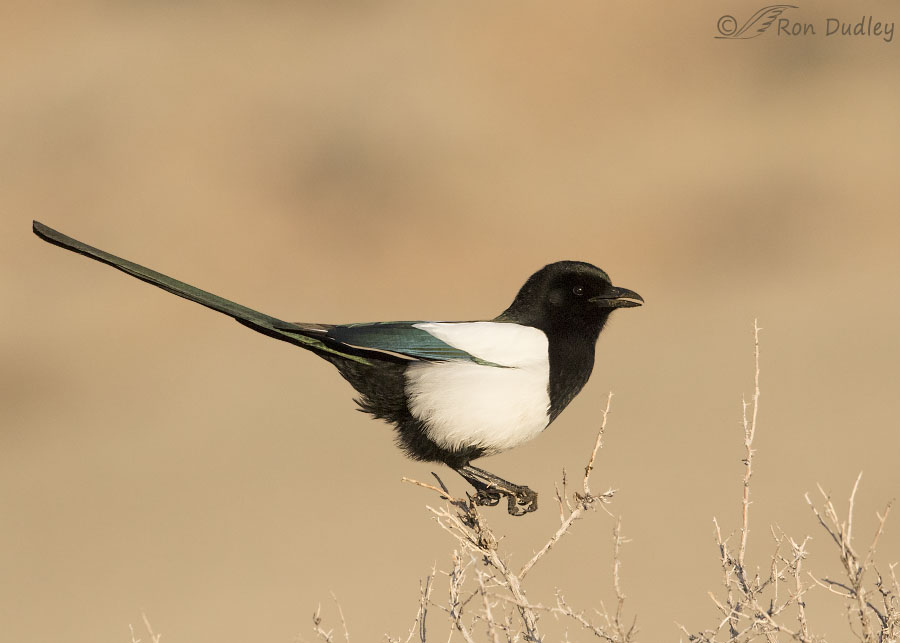
1/3200, f/5.6, ISO 800, Canon 7D Mark II, Canon EF 500mm f/4L IS II USM + EF 1.4 III Extender, not baited, set up or called in
I arrived on scene right after sunrise so the light was very warm at first and that has a slightly funky reddish effect on some of the blacks. This bird was taking a break before resuming its nest-building duties but…
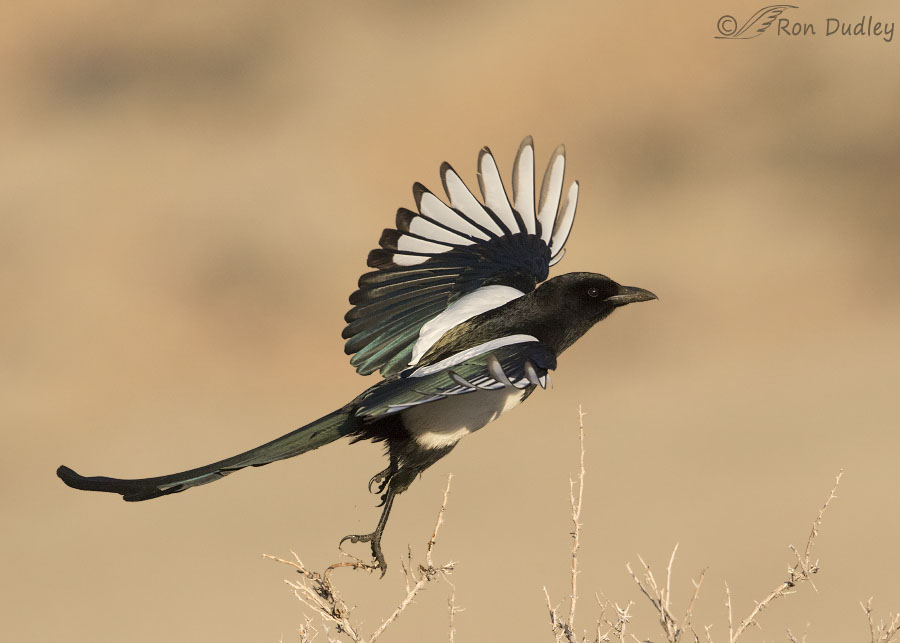
1/4000, f/5.6, ISO 800, Canon 7D Mark II, Canon EF 500mm f/4L IS II USM + EF 1.4 III Extender, not baited, set up or called in
I did catch it at takeoff.
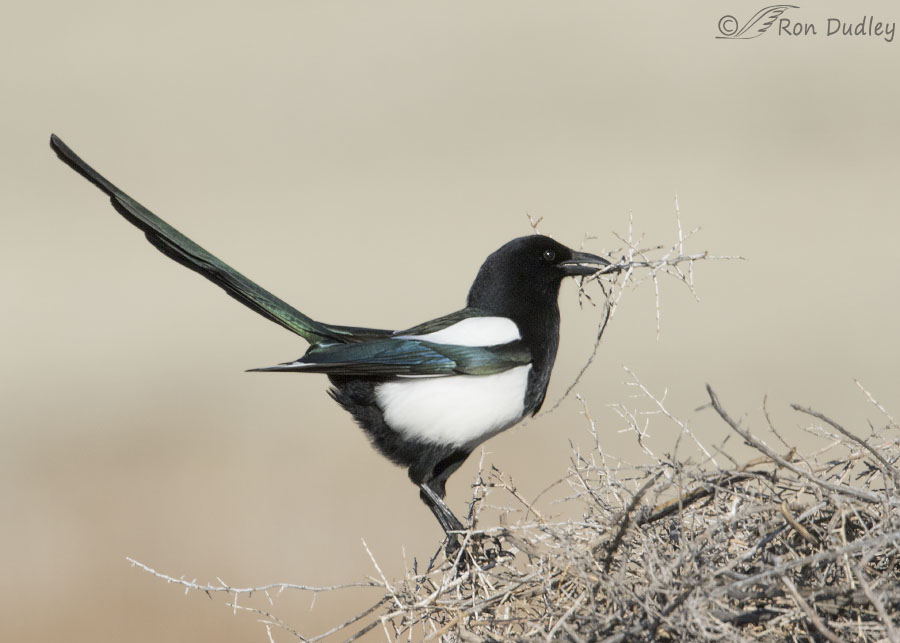
1/3200, f/7.1, ISO 800, Canon 7D Mark II, Canon EF 500mm f/4L IS II USM + EF 1.4 III Extender, not baited, set up or called in
Once the sun was a little higher in the sky the light was less warm but that makes the dried grasses in the background fairly bright and I don’t think that background is flattering for these black and white birds. I’m really looking forward to the grasses and bushes greening up and providing some color back there. I’m not fond of the background in any of these images but this is a documentary post about nest-building so I’m just going to try to look past it.
Most of the time the nesting material they brought in was twigs and sticks, from small to fairly large. Then they would try to “weave” them into the previous construction of the nest but that was awkward and difficult to do and watching them attempt it can be pretty amusing.
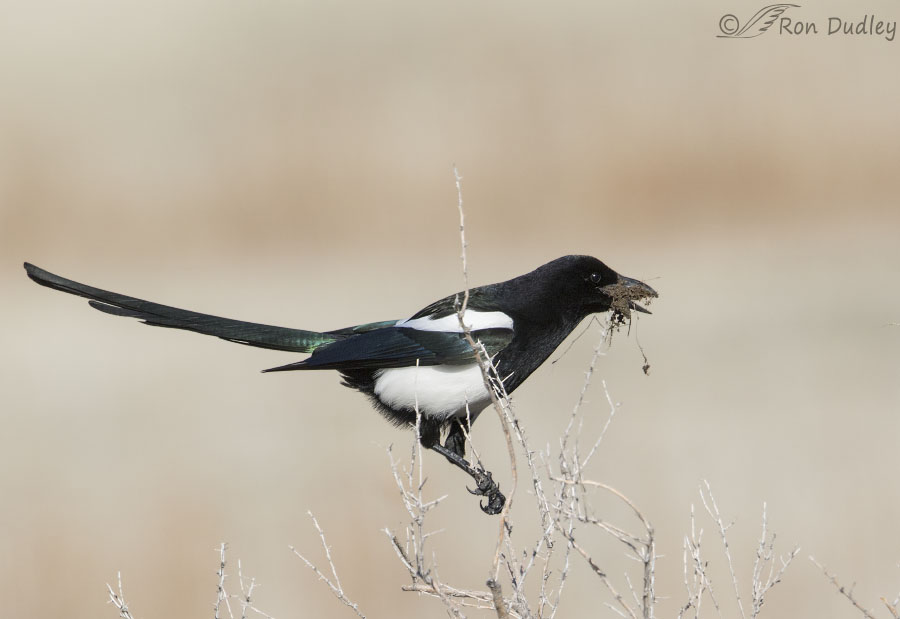
1/2500, f/7.1, ISO 800, Canon 7D Mark II, Canon EF 500mm f/4L IS II USM + EF 1.4 III Extender, not baited, set up or called in
But other times the nesting material of choice was mud or a mud and grass mixture that they use to line the interior chamber of their domed nest. Occasionally they use bison fur to line the nest cup. On this morning I watched as one of the magpies picked shedding fur off of a bison’s back which I tried to document with a few photographs but I couldn’t quite get an angle on the bison with my long lens through my pickup window.
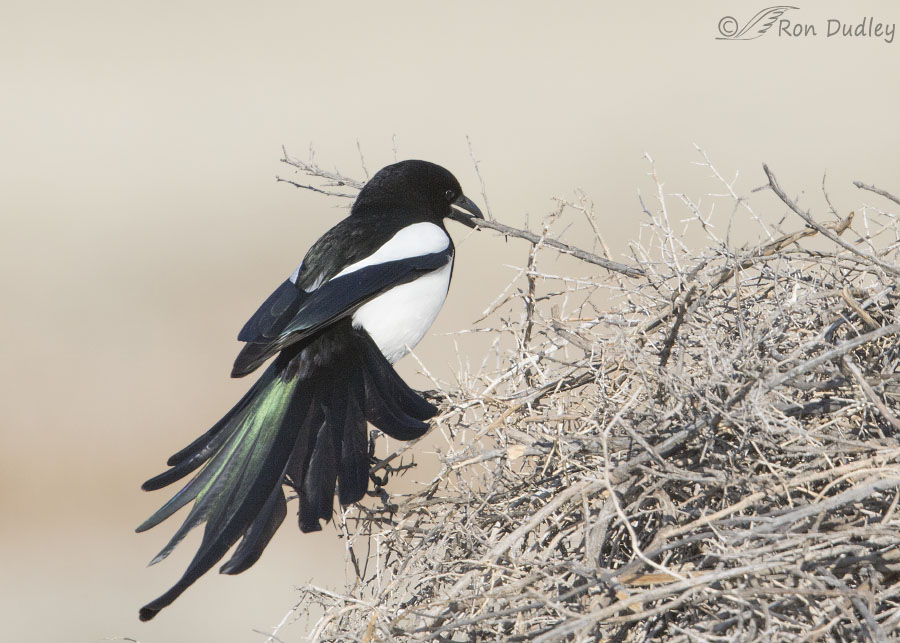
1/3200, f/7.1, ISO 800, Canon 7D Mark II, Canon EF 500mm f/4L IS II USM + EF 1.4 III Extender, not baited, set up or called in
But usually it was a twig or stick and sometimes it was quite bulky and much longer than this one. I love that spread tail as this bird landed.
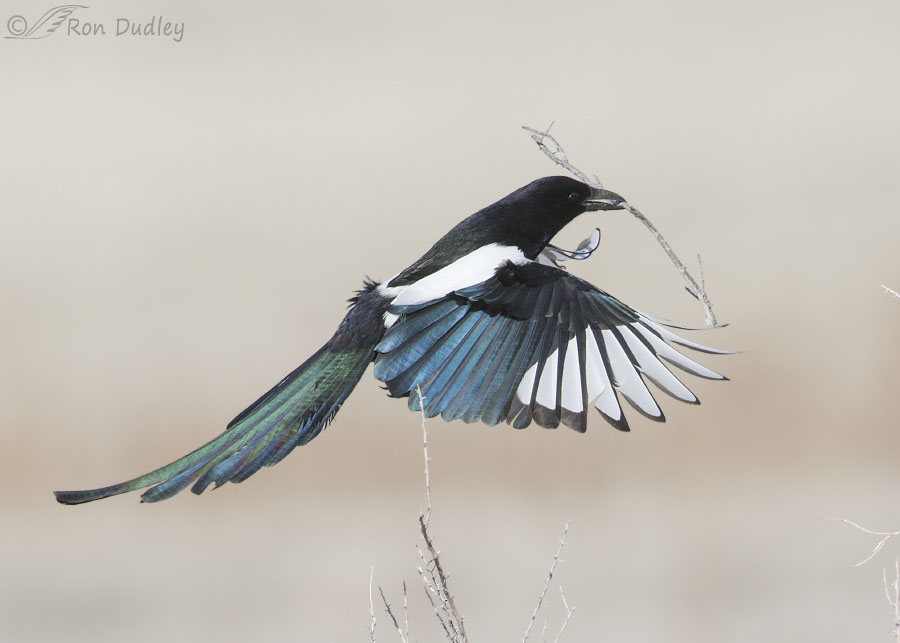
1/3200, f/7.1, ISO 640, Canon 7D Mark II, Canon EF 500mm f/4L IS II USM + EF 1.4 III Extender, not baited, set up or called in
I don’t think the iridescence (when I can get it) is set off as nicely by these background colors but I’m still happy to get it. This bird is about to land on top of the domed nest just out of frame to the right.
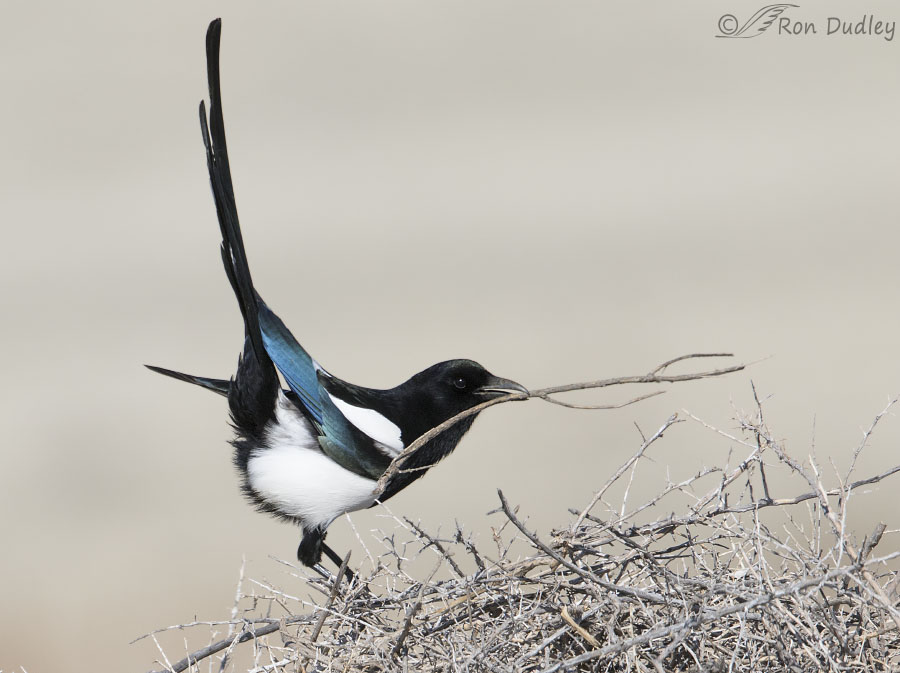
1/3200, f/7.1, ISO 640, Canon 7D Mark II, Canon EF 500mm f/4L IS II USM + EF 1.4 III Extender, not baited, set up or called in
I wish I liked some of the photos of them trying to weave the sticks into the nest but usually their face is largely hidden and we can’t see the eye.
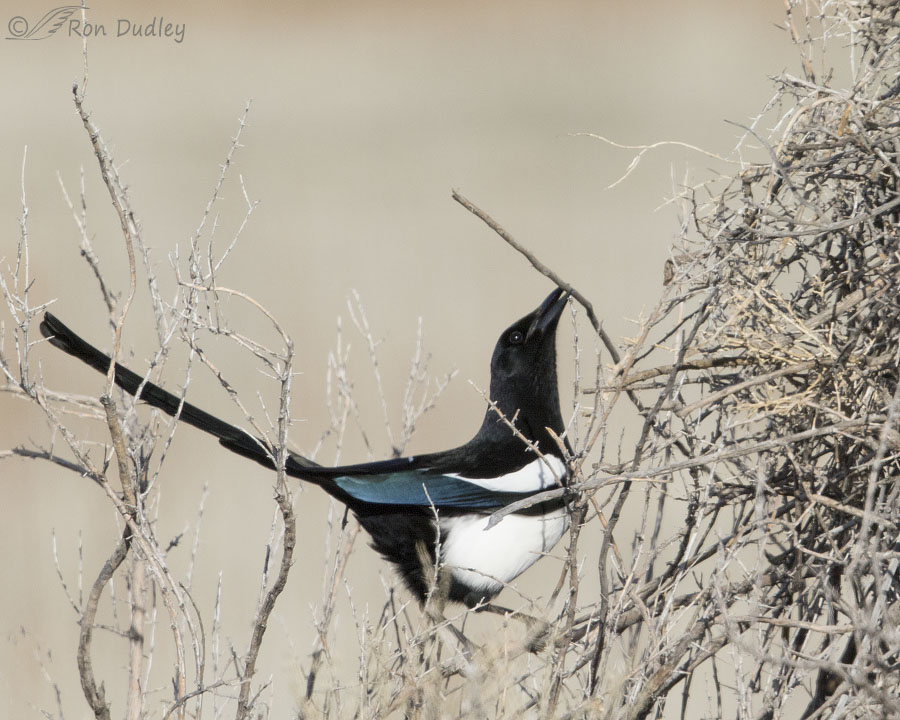
1/4000, f/7.1, ISO 500, Canon 7D Mark II, Canon EF 500mm f/4L IS II USM + EF 1.4 III Extender, not baited, set up or called in
This bird has an almost impossible goal. It’s apparent intention was to take this long unwieldy stick near or into the nest entrance (which we can’t see at this angle) but the thick tangle of twigs very near the nest present an almost insurmountable obstacle. It wrestled with this stick for some time in an attempt to get it free of all the obstacles before it…
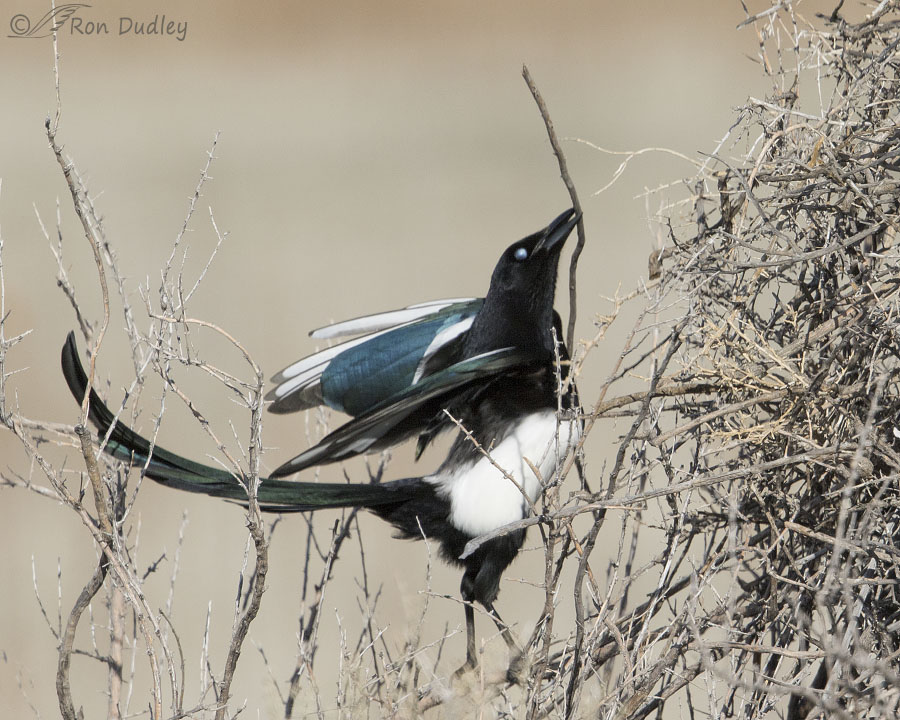
1/4000, f/7.1, ISO 500, Canon 7D Mark II, Canon EF 500mm f/4L IS II USM + EF 1.4 III Extender, not baited, set up or called in
launched the very short distance to its destination. In this tangle of twigs that are potential threats to their eyes their nictitating membranes are often closed for protection. In this species the membrane is an opaque bluish-white that is very easily seen because magpies flash their membranes to other magpies as a form of communication.
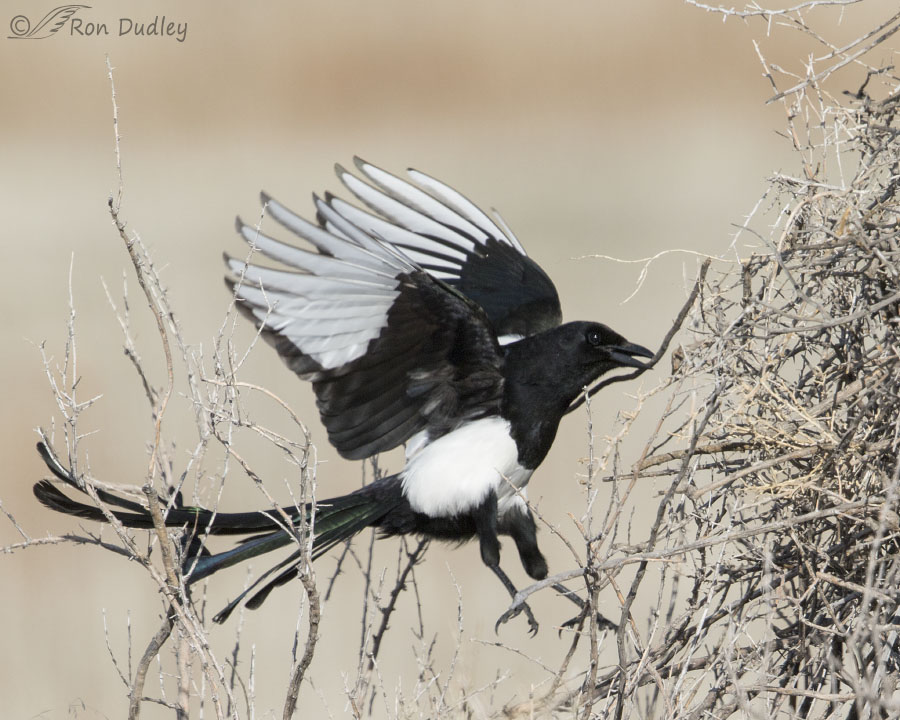
1/3200, f/7.1, ISO 500, Canon 7D Mark II, Canon EF 500mm f/4L IS II USM + EF 1.4 III Extender, not baited, set up or called in
This is the last shot I got before the bird’s head disappeared in the tangle of the nest. We can see why their feathers often become ratty-looking during the nest-building process.
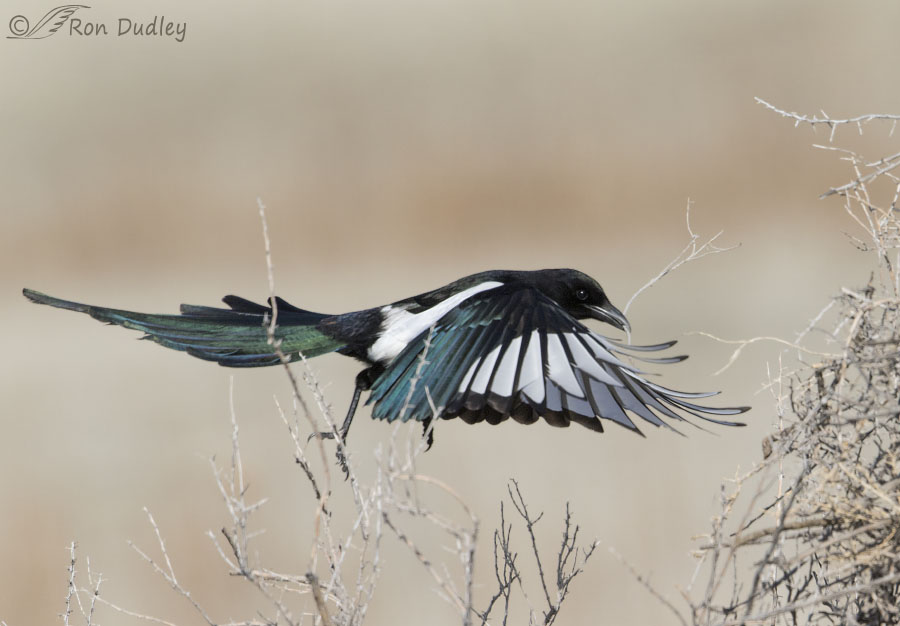
1/3200, f/7.1, ISO 500, Canon 7D Mark II, Canon EF 500mm f/4L IS II USM + EF 1.4 III Extender, not baited, set up or called in
These birds would often land on this smaller bush right in front of the nest and use it as a launching pad for their final approach to the nest directly in front of them. I’m sure they deliberately use that perch as the spot from which they make their plan about precisely where that particular piece of nesting material will be placed. Here it’s just a small twig.
I love watching and photographing these nest-building behaviors while they last but once the eggs are laid and incubation begins I’ll have far fewer opportunities with them so I have to enjoy it while I can.
Ron


WHAT a privilege to see. And what an incredible (yearly) feat they have ahead of them.
Thank you, thank you, thank you.
I’m glad you enjoyed it, EC. Thanks.
OUTSTANDING behavioral series Ron!
Charlotte
Thanks Charlotte.
You’re going to quibble with me, but these images are magnificent–every last one of them! Now, don’t start with me. I’m cranky and grumpy this morning and you will not win. Resistance is futile
Oh how I wish we had magpies in northern Arizona! As I’ve mentioned before, I just love the whole darn corvid family and magpies are just special.
As usual, I just love the behavioral series! Birds’ nest-building skills always amaze me. Who needs thumbs when you can weave and build a nest with only a beak? And those nests are sturdy! The Cornell redtail hawk nest survived a hurricane with nary a twig disturbed. Granted, it was a little hurricane, but the point stands. LOL!
The next time you’re out with the nesting magpies can you include a shot of the whole nest, please? They’re amazing constructs and I’m sure your followers who have never seen one will love it!
Steven E. Hunnicutt, thanks for the info on the Irish tradition! I’m certain to remember that and my Irish ancestry is deep enough that I’ll have to greet every magpie I see from this day forward. Thank you!
My computer is being evil again! It didn’t give me the option to follow your posts, so I’m giving it a second try. Jeesh!
There we go. Second attempt was successful.
Thank you, Laura. This nest can be seen in several images in the following post. The photos are 2+ years old but the nest still looks similar to this.
https://www.featheredphotography.com/blog/2016/08/04/anatomy-of-a-magpie-nest/
Very diligent builders indeed! I love that info from Steven!
Me too!
Great series Ron. I think I like the image with the Magpies tail almost straight up in the air and, actually, I like the red-ish background of the early morning light. Thanks again for your morning delights.
Thank you, Frank.
That one thing I love to see , the nest What a job Right now we’re lucky enough to be watching a pair of eagles. Looking through a telescope really gives a up close look at the work of art a nest is. An egg hatched 2 days ago
Right now we’re lucky enough to be watching a pair of eagles. Looking through a telescope really gives a up close look at the work of art a nest is. An egg hatched 2 days ago
 It’s going to be a fun time.
It’s going to be a fun time.
I wish more Bald Eagles nested around here, Diana. Only a few of them do because most of ours head north for that purpose.
Wonderful, wonderful series…love the iridescence and information…amazing how nature has bison shedding big clumps of their soft, warm winter coats at the same time birds are building and lining their nests…
I’ve always thought that timing was pretty interesting too, Patty. Ain’t nature grand!
Beautiful bird, beautiful pictures Ron, and educational as well. Regarding the Good Morning Mr. Magpie comments, that is the same in Wales. I have a Welsh friend who had me loudly laughing years ago as he told me of their superstition about having to say Good Morning Mr. Magpie and how frantic he would be trying to do that when a flock of them flew by and he was obligated to say it for each and everyone one of them. Envy you having those Magpies there Ron.
Everett Sanborn, Prescott AZ
I enjoyed your entertaining magpie story, Everett!
Ron,
Nice shots. Thanks for the pics and the activity and explanation. Light is a fickle mistress.
I hope you are feeling better.
Stephen
Thanks, Stephen. Some of my health issues have been improving but I still have a ways to go…
What a FINE series of captures— I really enjoyed these pictures, and was intrigued by your mention of the fact that Magpies raise their dictating membranes as a “means of
communication”.– Any idea of what kind of communication ( besides “I really don’t want to put out my eye with these twigs” ) ?
Kris, I learned that little tidbit about them communicating with their membranes on BNA Online several years ago. I can’t remember precisely what it communicates and my BNA subscription has run out until I get around to renewing it. Gotta do that!
Beautiful and interesting photo’s Ron. I’m not fully appreciative at the moment as they are refurbishing a nest near the bedroom windows that they abandoned last year………
I felt the same way when magpies were nesting in my huge elm next to my house for two seasons. The noise drove me nuts sometimes.
Your pictures are breathtaking! Thank you so much for sharing.
I’m glad you enjoyed them, Mary.
Feeling the magpie love – very cool series!
Thanks, Robyn.
Nice series! I love these guys!
Thanks, LS.
Having been to Ireland a couple of times, one must say Good Morning to a Magpie when you see one. Also on the blue part of the wings is where the Feries are. On both trips, some people with the group thought it was funny and foolish, the people believe, respect, and I do so. Oh Yes these pictures are outstanding, jealous. Will be replacing my 7D for the Mark II and thank you for answering my questions I asked previous on cameras.
Interesting Irish traditions, Steven. Thanks for providing them.
I predict you’re going to love your 7DII although you might find the initial setup quite complicated compared to the 7D. But you sure have a lot of potentially useful settings in the menu of the Mark II that you don’t have with the 7D.